Multiphysics Coupling Simulation of Off-Axis Integrated Cavity Optical Sensing System
Abstract
:1. Introduction
2. Optical Mechanical Thermal Simulation Analysis Process
3. Modeling and Simulation of Multiphysics Coupling Model
3.1. Geometric Model
3.2. Grid
3.3. Multiphysical Field
3.3.1. Geometrical Optics Physics Field
3.3.2. Solid Mechanics Physics Field
3.3.3. Solid Heat Transfer Physics Field
4. Results and Discussion
4.1. Stress Analysis
4.2. Thermal Deformation Analysis
4.3. Deformation Analysis of the First Mirror
4.4. Spot Diagram Analysis
5. Conclusions
Author Contributions
Funding
Institutional Review Board Statement
Informed Consent Statement
Data Availability Statement
Conflicts of Interest
References
- Liu, Y.X.; Wang, Z.B.; Wei, X.X.; Wang, J.J.; Meng, X.; Mao, G.L. Simultaneous detection of CH4 and CO2 through dual modulation off-axis integrated cavity output spectroscopy. Chin. Phys. B 2023, 32, 104209. [Google Scholar] [CrossRef]
- Ngo, M.; Nguyen-Ba, T.; Dewaele, D.; Cazier, F.; Zhao, W.X.; Nähle, L.; Chen, W.D. Wavelength modulation enhanced off-axis integrated cavity output spectroscopy for OH radical measurement at 2.8 µm. Sens. Actuat. A Phys. 2023, 362, 114654. [Google Scholar] [CrossRef]
- Yang, X.; Zhang, Z.R.; Xia, H.; Sun, P.S.; Pang, T.; Wu, B.; Liu, X.; Guo, Q. Re-injection off-axis integrated cavity output spectroscopy for the simultaneous detection of N2O, H2O and CO with a mid-infrared QCL laser. Analyst 2024, 149, 909–916. [Google Scholar] [CrossRef] [PubMed]
- Zheng, K.Y.; Zhang, L.; Leng, S.; Xi, Z.H.; Zheng, C.T.; Wang, Y.D.; Tittel, F.K. An exhaled breath gas sensor system for near-infrared ammonia measurement and kidney diagnostics. Spectrochim. Acta A 2024, 321, 124625. [Google Scholar] [CrossRef]
- Shao, L.G.; Mei, J.X.; Chen, J.J.; Tan, T.; Wang, G.S.; Liu, K.; Gao, X.M. Recent advances and applications of off-axis integrated cavity output spectroscopy. Microw. Opt. Technol. Let. 2022, 65, 1489–1505. [Google Scholar] [CrossRef]
- Long, F.Y.; Gao, G.Z.; Zhang, M.K.; Jiang, Y.H.; Cai, T.D. Multi-laser sensor for simultaneous multi-gas measurements using off-axis cavity-enhanced absorption spectroscopy with an opposite two-way configuration. Opt. Lett. 2022, 47, 1339–1342. [Google Scholar] [CrossRef] [PubMed]
- Tian, X.; Cheng, G.; Cao, Y.N.; Chen, J.J.; Liu, K.; Gao, X.M. Simultaneous detection of hydrogen sulfide and carbon dioxide based on off-axis integrated cavity output spectroscopy using a near-infrared distributed feedback diode laser. Microw. Opt. Technol. Let. 2021, 63, 2074–2078. [Google Scholar] [CrossRef]
- Yuan, Z.H.; Huang, Y.B.; Zhao, Q.; Zhang, L.L.; Lu, X.J.; Huang, J.; Qi, G.; Luo, T.; Cao, Z.S. Dual-path coupling V-shaped structure off-axis integrated cavity output spectroscopy (V-OA-ICOS) for water vapor stable isotope detection at 3.66 μm. Sens. Actuat. B Chem. 2024, 410, 135676. [Google Scholar] [CrossRef]
- Gao, Q.Y.Y.; Zheng, Y.Q.; Wang, L.; Li, C.L.; Zhang, J.L.; Wu, H.; Han, Y.X.; Wang, S. Designing a Long Optical Path Direct-Injection-Integrated Cavity for Laser Absorption Spectroscopy. Photonics 2023, 11, 36. [Google Scholar] [CrossRef]
- He, Q.Y.; Chang, J.; Li, J.K.; Zheng, C.T.; Tittel, F.K. On-line measurement of atmospheric oxygen by an open-path OA-ICOS based sensor with high accuracy at ambient pressure. Infrared Phys. Technol. 2023, 131, 104699. [Google Scholar] [CrossRef]
- Moyer, E.J.; Sayres, D.S.; Engel, G.S.; Clair, J.M.; Keutsch, F.N.; Allen, N.T.; Kroll, J.H.; Anderson, J.G. Design considerations in high-sensitivity off-axis integrated cavity output spectroscopy. Appl. Phys. B Lasers Opt. 2008, 92, 467–474. [Google Scholar] [CrossRef]
- Chu, Y.F.; Wang, Z.E.; Xue, L.L.; Deng, M.; Lin, G.; Xie, H.L.; Shin, H.H.; Li, W.W.; Firl, G.; D‘Amico, D.F.; et al. Characterizing warm atmospheric boundary layer over land by combining Raman and Doppler lidar measurements. Opt. Express 2022, 30, 11892–11911. [Google Scholar] [CrossRef] [PubMed]
- Li, A.H.; Bian, Y.M.; Liang, Y.C.; Zhu, Y.J. Integrated design for large-scale opto-mechanical structure. Opt. Appl. 2009, 39, 383–389. [Google Scholar]
- Li, L.; Xing, K.M.; Zhao, M.; Wang, B.X.; Chen, J.F.; Zhuang, P. Optical–Mechanical Integration Analysis and Validation of LiDAR Integrated Systems with a Small Field of View and High Repetition Frequency. Photonics 2024, 11, 179. [Google Scholar] [CrossRef]
- Trim, S.J.; Butler, S.L.; Spiteri, R.J. Benchmarking multiphysics software for mantle convection. Comput. Geosci. 2021, 154, 104797. [Google Scholar] [CrossRef]
- Zhao, X.T.; He, F.Y.; Xue, Y.W.; Ma, W.H.; Yin, X.H.; Xia, S.K.; Zeng, M.J.; Du, G.X. High-resolution imaging of magnetic fields of banknote anti-counterfeiting strip using fiber diamond probe. Chin. Phys. B 2024, 33, 048502. [Google Scholar] [CrossRef]
- Codau, E.; Codau, T.C.; Lupu, I.G.; Raru, A.; Farima, D. Heat transfer simulation through textile porous media. J. Text. Inst. 2023, 114, 257–264. [Google Scholar] [CrossRef]
- Che, C.Q.; Yan, B.F.; Fu, C.J.; Li, G.N.; Qin, C.X.; Liu, L.Q. Improvement of cable current carrying capacity using COMSOL software. Energy Rep. 2022, 8, 931–942. [Google Scholar] [CrossRef]
- Kumar, B.; Banerjee, A.; Das, R.; Manna, B. Frequency dependent effective modulus of square grid lattice using spectral element method. Mech. Mater. 2023, 184, 104695. [Google Scholar] [CrossRef]
- Wang, J.G.; Gao, C.; Duan, X.; Mao, K. Multi-field Coupling Simulation and Experimental Study on Transformer Vibration Caused by DC Bias. J. Electr. Eng. Technol. 2015, 10, 176–187. [Google Scholar] [CrossRef]
- Zhao, W.K.; Teng, Y.; Tang, K.; Zhu, S.M.; Yang, K.; Duan, J.J.; Huang, Y.M.; Chen, Z.A.; Ye, J.D.; Gu, S.L. Significant suppression of residual nitrogen incorporation in diamond film with a novel susceptor geometry employed in MPCVD. Chin. Phys. B 2022, 31, 118102. [Google Scholar] [CrossRef]
- Callegari, A.; Mijalkov, M.; Gököz, A.B.; Volpe, G. Computational toolbox for optical tweezers in geometrical optics. J. Opt. Soc. Am. B 2015, 32, 11–19. [Google Scholar] [CrossRef]
- Jin, H.X.; Zhang, E.R.; Espinosa, H.D. Recent Advances and Applications of Machine Learning in Experimental Solid Mechanics: A Review. Appl. Mech. Rev. 2023, 75, 061001. [Google Scholar] [CrossRef]
- Patel, M.S.; Yong, Y.K.; Tanaka, M. Drive level dependency in quartz resonators. Int. J. Solids Struct. 2009, 46, 1856–1871. [Google Scholar] [CrossRef]
- Luzzi, L.; Cammi, A.; Marcello, V.; Fiorina, C. An approach for the modelling and the analysis of the MSR thermo-hydrodynamic behaviour. Chem. Eng. Sci. 2010, 65, 4873–4883. [Google Scholar] [CrossRef]
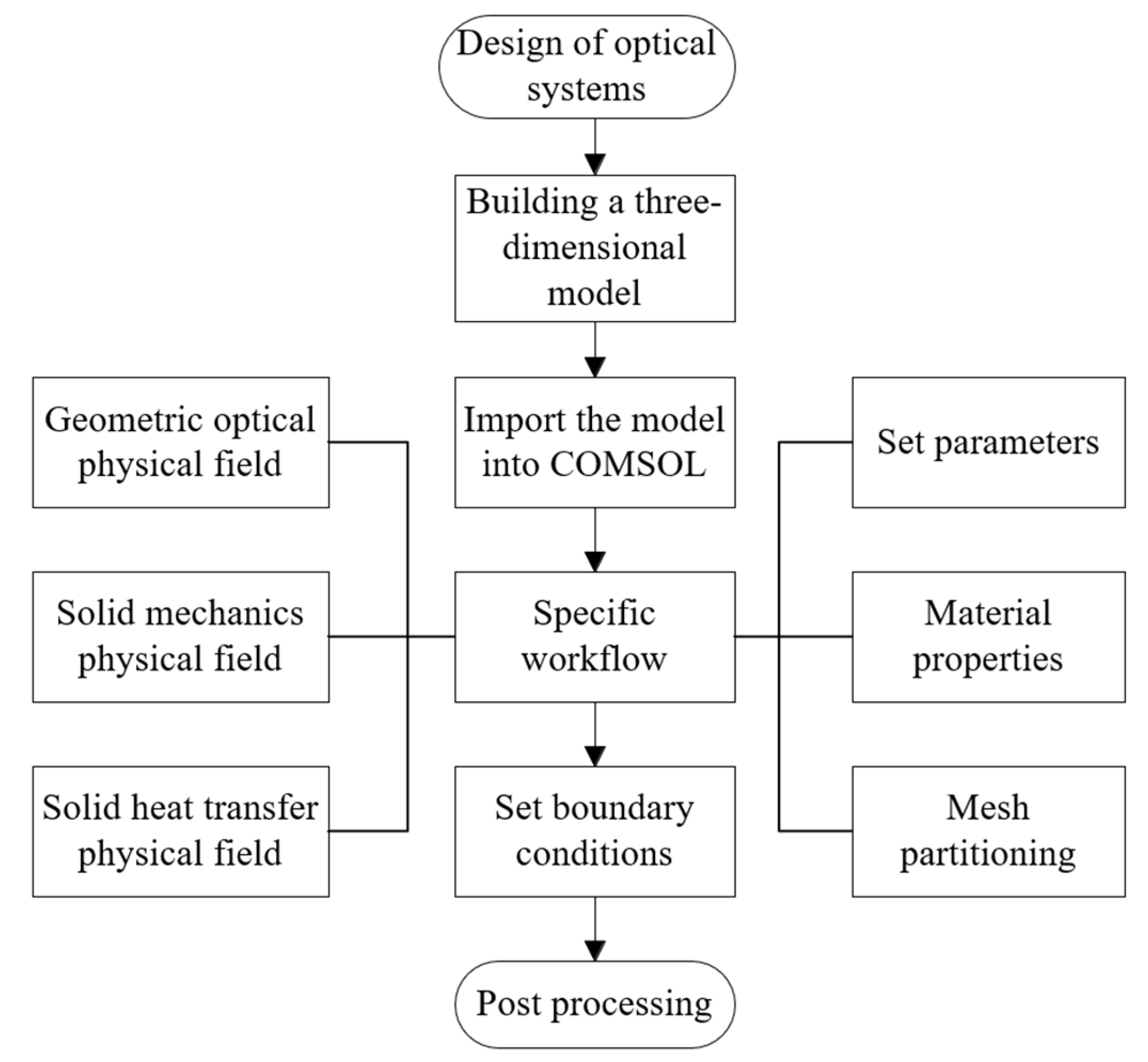
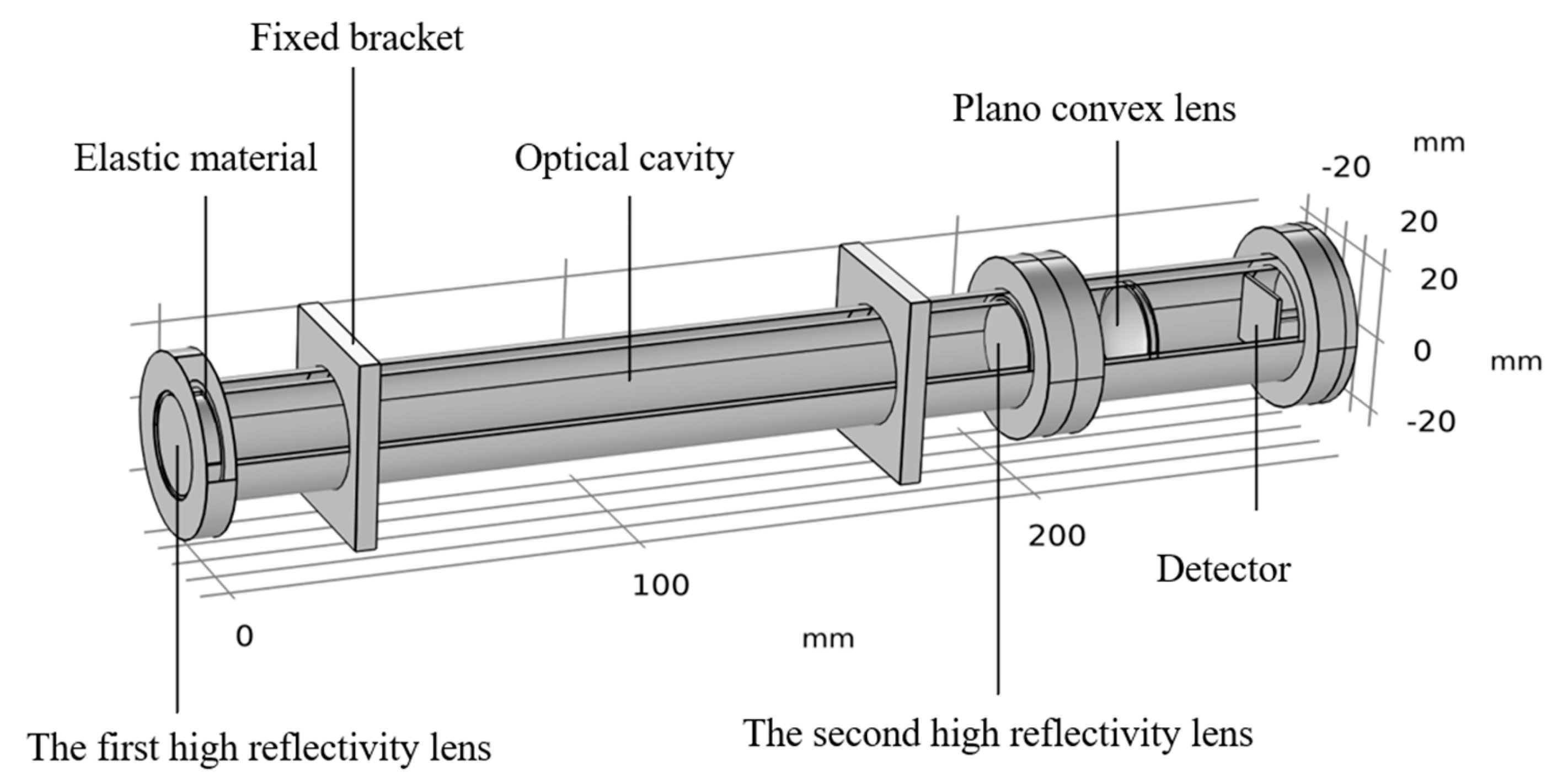
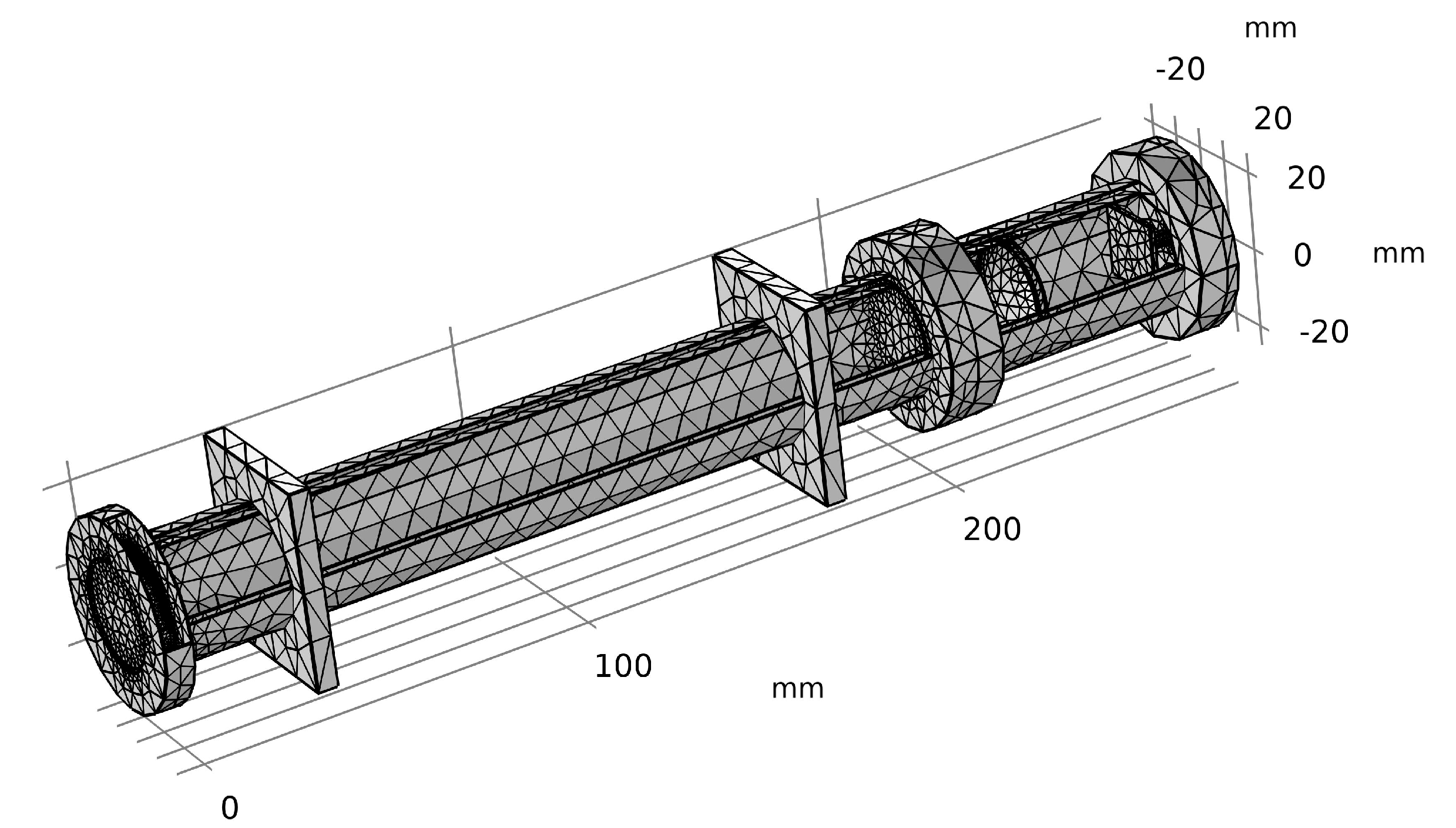
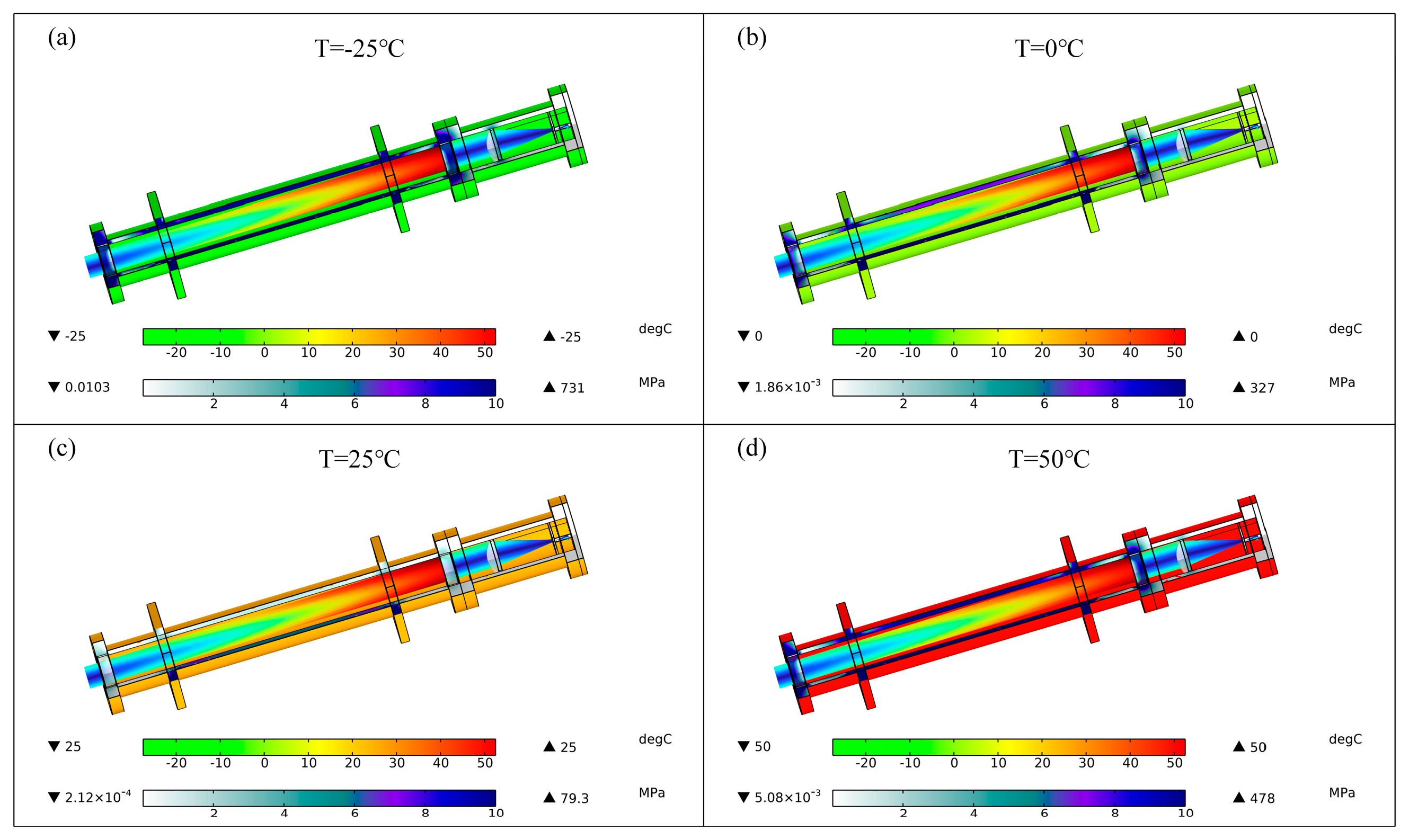

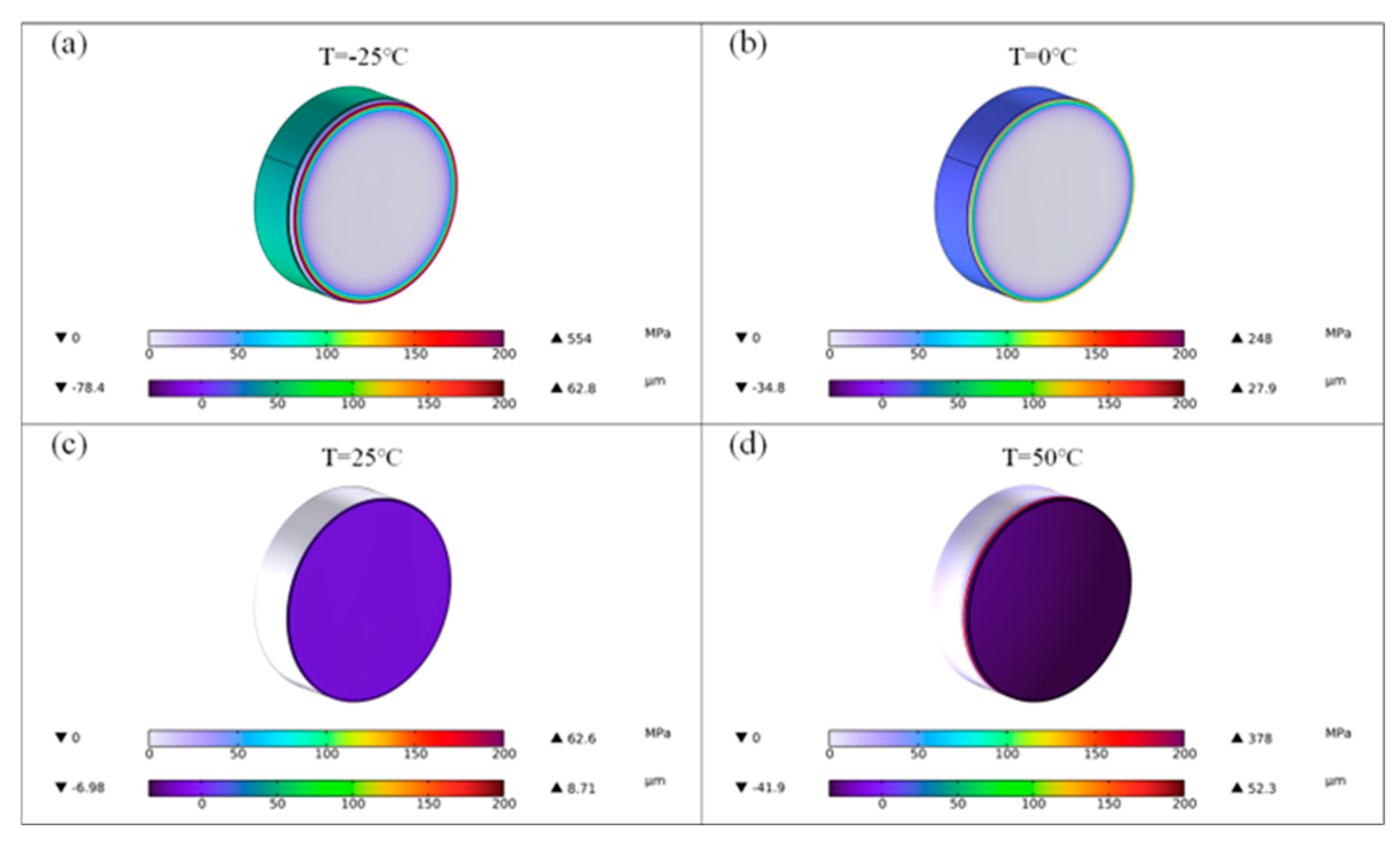
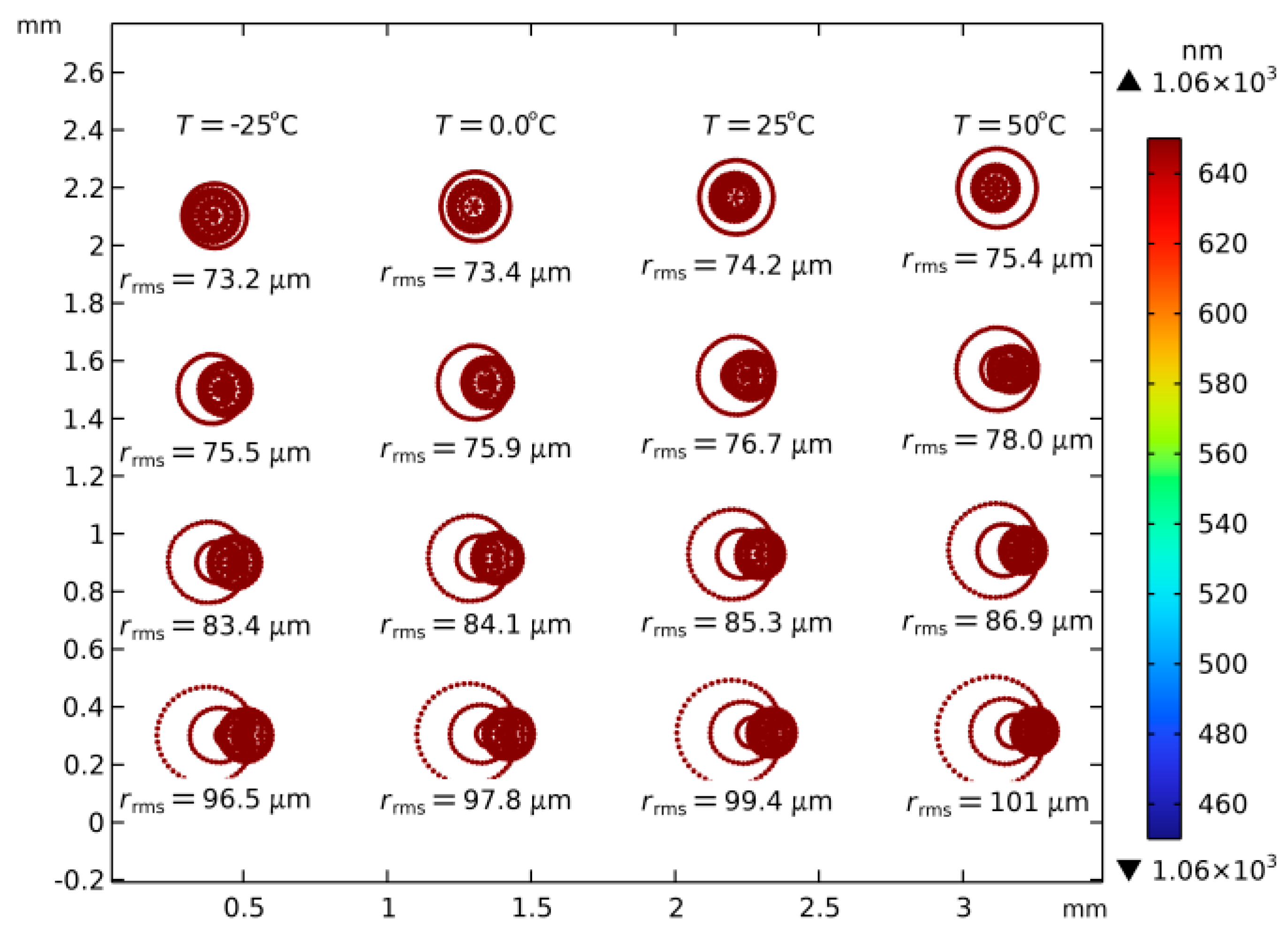


| Coefficient of Thermal Expansion (1/K) | 12.3 × 10−6 |
| Heat capacity at constant pressure (J/kg·K) | 475 |
| Relative dielectric constant | 1 |
| Density (kg/m3) | 7850 |
| Thermal conductivity (W/m·K) | 44.5 |
| Young’s modulus (GPa) | 205 |
| Poisson’s ratio | 0.28 |
Disclaimer/Publisher’s Note: The statements, opinions and data contained in all publications are solely those of the individual author(s) and contributor(s) and not of MDPI and/or the editor(s). MDPI and/or the editor(s) disclaim responsibility for any injury to people or property resulting from any ideas, methods, instructions or products referred to in the content. |
© 2024 by the authors. Licensee MDPI, Basel, Switzerland. This article is an open access article distributed under the terms and conditions of the Creative Commons Attribution (CC BY) license (https://creativecommons.org/licenses/by/4.0/).
Share and Cite
Tian, X.; Yuan, J.; Chen, S.; Cao, X.; Mu, T.; Cheng, G. Multiphysics Coupling Simulation of Off-Axis Integrated Cavity Optical Sensing System. Photonics 2024, 11, 720. https://doi.org/10.3390/photonics11080720
Tian X, Yuan J, Chen S, Cao X, Mu T, Cheng G. Multiphysics Coupling Simulation of Off-Axis Integrated Cavity Optical Sensing System. Photonics. 2024; 11(8):720. https://doi.org/10.3390/photonics11080720
Chicago/Turabian StyleTian, Xing, Jun Yuan, Shichao Chen, Xile Cao, Tong Mu, and Gang Cheng. 2024. "Multiphysics Coupling Simulation of Off-Axis Integrated Cavity Optical Sensing System" Photonics 11, no. 8: 720. https://doi.org/10.3390/photonics11080720




